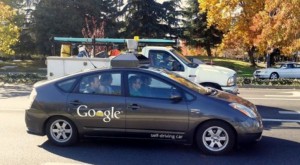They’ve long been the stuff of science fiction, but a new study predicts that once they come to market in the near future, autonomous vehicles will rapidly become a very popular reality.
The study, titled “Emerging Technologies: Autonomous Cars — Not If, But When,” predicts that by 2035, self-driving cars, or SDCs, will account for half the vehicles sold in North America. Worldwide sales will reach about 11.8 million, according to IHS Automotive, which prepared the report. By 2050, the consulting firm predicts, almost all vehicles will offer an autonomous mode.
Officials at Nissan recently promised to put their first autonomous vehicles into production by 2020, and a number of other makers have since made similar announcements. The IHS report notes that the first generation of these vehicles will actually require a human co-pilot to sit at the ready in case the technology develops a problem – much like an aircraft autopilot. But it anticipates truly independent, self-driving vehicles requiring no human involvement will begin to be offered by 2030.
The study predicts that as the technology improves, demand will increase, as well – from around 230,000 SDCs annually in 2025 to 11.8 million sold worldwide by 2035. The study predicts that about a third of those vehicles will be sold in North America.
Not everyone is quite so confident. In fact, there’s an ongoing debate about where autonomous vehicles will first come to market. Andy Palmer, the Nissan Motor Co. global product czar, recently cautioned that because of the litigious nature of the American market, manufacturers “might” have to steer clear of the U.S. unless legislators take steps to protect the industry from a flood of frivolous lawsuits.
The irony, proponents say, is that autonomous vehicles could yield massive reductions in collisions, injuries and highway fatalities.
(Michigan approves on-road testing for self-driving cars. For more, Click Here.)
“As the market share of SDCs on the highway grows, overall accident rates will decline steadily,” said Egil Juliussen, principal analyst for autonomous driver-assisted systems, who co-authored the IHS study. “Traffic congestion and air pollution per car should also decline, because SDCs can be programmed to be more efficient in their driving patterns.”
(Click Here to see how millennials are pushing for driverless cars.)
There are, of course, other issues to overcome if the IHS forecast is to prove accurate. Even proponents of the technology acknowledge they will have to make major improvements in software programming to handle all the various challenges a human motorist might face on the road. Sensors and computing systems must become not only more powerful but also more robust. And there’s even the issue of cyber-security, especially as future SDCs will likely tie into vehicle-to-vehicle and vehicle-to-roadway communications networks to track traffic, weather and construction.
Though Nissan’s Palmer told TheDetroitBureau.com the goal is to make autonomous technology “affordable,” the new study cautions that autonomous vehicles will likely carry a $7,000 to $10,000 premium over similar, but conventionally operated products in 2025. But it also anticipates the cost penalty will dip to $5,000 by 2030 and just $3,000 by 2035, taking advantage of the same sorts of economies of scale that have driven down prices of consumer electronic goods such as TVs and smartphones.


This will prove to be interesting when the drivers claim the vehicle was actually driving when they crash…
Jorge,
Expect to see black boxes the norm on autonomous vehicles, likely gathering much more data than on current vehicles with the devices.
Paul E.